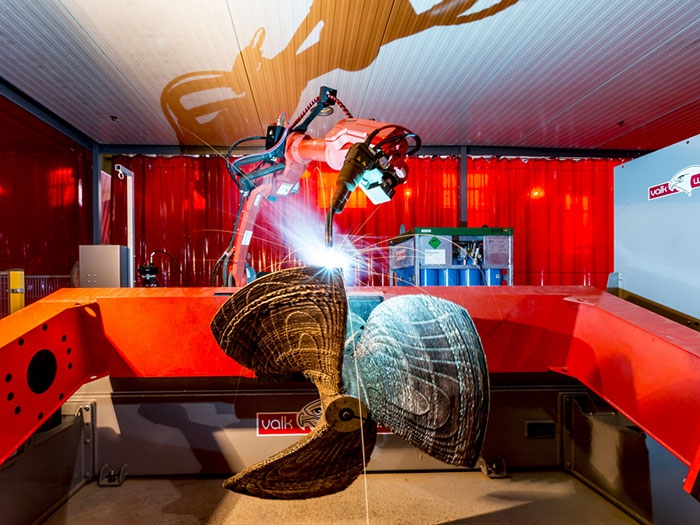
Prototype propeller produced by 3D printing
Written by Nick Blenkey
Production will start next month on class approved printed propellrr
SEPTEMBER 11, 2017 — A prototype of a 1,350 mm diameter ship’s propeller has been completed using additive manufacturing (3D printing) techniques. Named WAAMpeller, the prototype has been produced by a cooperative consortium that includes Damen Shipyards Group, RAMLAB, Promarin, Autodesk and Bureau Veritas.
This first prototype WAAMpeller will be used for display purposes, but planning for a second example, that will have class approval, is already underway. “We start production of a second propeller with class approval later next month – using all the lessons we have learned over the past few months,” says Kees Custers, Project Engineer in Damen’s R&D department. “We are aiming to install this second one onto one of our tugs later this year.”
The WAAMpeller was fabricated from a nickel aluminium bronze (NAB) alloy at RAMLAB (Rotterdam Additive Manufacturing Lab) in the Port of Rotterdam. The propeller was produced with the wire arc additive manufacturing (WAAM) method using a Valk welding system and Autodesk software. The triple-blade structure uses a Promarin design that is used on Damen’s Stan Tug 1606. With production complete, the WAAMpeller will be CNC milled at Autodesk’s advanced manufacturing facility in Birmingham, U.K.
The prototype 3D printed propeller represents a steep learning curve in the understanding of material properties.
“This is because 3D printed materials are built up layer by layer,” says Mr. Custers. “As a consequence, they display different physical properties in different directions – a characteristic known as anisotropy. Steel or cast materials, on the other hand, are isotropic – they have the same properties in all directions.”
Because of this critical difference, one of the first steps was to carry out extensive testing of the material properties of the printed material to ensure compliance to Bureau Veritas standards. This involved printing two straightforward walls of material then using a milling machine to produce samples for lab testing of tensile and static strengths.”
The 400 kg WAAMpeller also marks a milestone in terms of 3D printing production techniques.
“The challenge has been to translate a 3D CAD file on a computer into a physical product. This is made more complex because this propeller is a double-curved, geometric shape with some tricky overhanging sections,” says Mr Custers.
Yannick Eberhard of Promarin’s R&D department adds that “the transformation from a semi-automatic to robotic processing is the solid foundation for even more complex and reliable future propeller designs”.
“Material characterization and mechanical testing have been an important part of this project,” says Wei Ya, Postdoctoral Researcher from the University of Twente at RAMLAB. “We have to make sure that the material properties meet the needs of the application. Material toughness, for example – ensuring that the propeller is able to absorb significant impact without damage.”
“But we have also been working towards optimising the production strategy for 3D metal deposition,” Mr. Ya continues. “This includes bead shape and width, as well as how fast we can deposit the printed material.”
RAMLAB as theh capacity to print objects with maximum dimensions of 7 x 2 x 2 m,
“For large scale 3D metal deposition, the WAAMpeller is really ground-breaking for the maritime industry,” says Mr. Ya. “This technology is a fundamental change in the concept of how we make things. With additive manufacturing, you can print most metallic components that are needed in principle. There is so much potential for the future – these techniques will have a big impact on the supply chain.”





Leave a Reply
You must be logged in to post a comment.